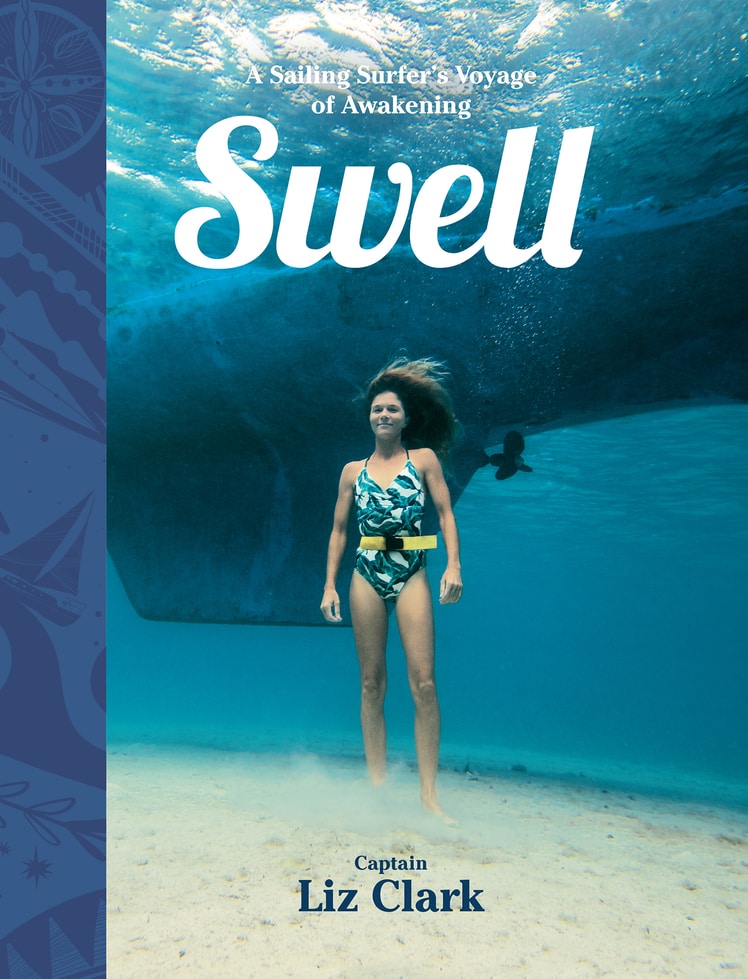Adrift

A few mornings later I stared intently at my computer screen in the belly of Swell, under deadline to finish a photo caption piece for Patagonia’s new story-telling internet forum, the Tin Shed. I heard a strong gust of wind followed by a squall rain but in my intent to finish the piece, I didn’t bother to move from my seated position at the nav table in my pajamas beside an empty morning’s tea cup and a crumpled biscuit wrapper. I remember that the gust subsided quickly and I’d thought to get up and have a look, but then got distracted again as I read and re-read through the piece. I’m not sure how much time passed between that gust and when I heard a voice outside.
“Aww…” I thought as I heard someone calling. “I am SO close to finishing!” I was literally listening for the SSB short-wave radio station to be free to attempt to send the writing piece to Patagonia through my radio email service.

I poked my head out to see who it was and squinted into the brightness. George’s big aluminum boat was outside, but two other guys were in it, one that I recognized from the surf.
“Oh, bonjour, hey, how’s it going?” As the words exited my mouth, I realized something about the situation was completely wrong. Where was I? I was no longer in front of George’s house. In fact, I was halfway across the lagoon!! It was as perfectly glassy as an overcast winter morning in Santa Barbara, but the boat had been silently drifting with the current. I played the events back in my head–the strong gust of wind, the urge to look out the window and then back to the computer screen…
“Um, just checking to see if everything’s okay? It seems like you’re boat is drifting?” He said.
“Holy… what the?… uh, yeah? I mean, no? I mean… yes!” My words ran mumbling off as I fumbled for the key below the steering station and started the engine. Up at the bow I discovered that the mooring line was hanging straight down, as taught and impossible to budge as if the line were connected to the Eiffel Tower, descending straight down into the abyss of the 200 foot deep lagoon. Still slightly baffled, I sat on the bow to think.
“Just cut the line!” They called to me in a panic. But no, that didn’t really seem necessary. I sat and reflected, there was no need to panic, the boat was hardly drifting and I still had over 200 yards before I would hit any coral — now how could this have happened? I had free dove 70 feet the day I’d arrived at George’s to check the mooring line and it had all looked good all the way to the bottom. I knew it was attached to a large, rectangular cement block, which was attached with chain around a coral head, now how on earth could I have pulled it off the bottom? How could it still be connected to the mooring line? Anyway, it IS still connected, and it’s deep all the way until the seafloor rises abruptly in front of George’s house and I don’t want to loose his mooring block, so I’ll just motor it across the bay until it hits the bottom in front of the house again?
“Don’t worry, guys it’s okay! I’m just going to take it back with me!” I called. I shifted slowly into gear and me and Swell and the mooring block chugged back across the bay, the boys following behind, until the bow swung around with the force of the block hitting bottom. I thanked the guys again for coming to help me and then quickly dove in with my mask and pulled myself down the mooring line to see where we’d landed.
I could tell that one of the two guys was a bit disappointed. He’d clearly hoped for a much more heroic role in my rescue, but in fact, it wasn’t really all that dramatic. Upon closer inspection, it was easy to see what had happened. I had tied my dock line through the mooring’s line loop and back to the boat. In front of the house, there is a current that makes the boat constantly twirl in light winds and after a few days of twisting without my attention, it had twisted itself up so tightly that it must have actually been pulling the mooring up off the seafloor. When the gust of wind came, it yanked on the old rusty chain and broke it. One gust was enough to slide the block off into deeper water, as the seafloor bottoms out steeply.




2 Comments
allan weidner
April 12, 2011sailing in the eastern sierra is not about mooring. but I have read harrowing accounts in Hal Roth’s Around the Cape and the classic Somewhere East of SueZ. not to forget some of Slocum’s tree tie-offs.
Adam Pappas
May 8, 2011Hey Liz. I’ve been following your journey and it has been a great inspiration to me. I am also planning a circumnavigation and so I have been trying to absorb as much information from those who have done this and obviously your knowledge would be very beneficial. I have just closed the deal on an Islander 41 which initially was not the kind of vessel I had planned to cruise in but it was a deal I couldn’t pass up. It’s an old 74′ IOR and its racing design is a little concerning to me since I don’t have experience in that type of boat. My previous boat was a Columbia 28 which I sailed extensively around Southern California and the Channel Islands. Since your Cal 40 is also considered a racer/cruiser I was wondering if you could give me some affirmation that these type of boats are fine for circumnavigating or what are some characteristics I should be aware of. Good luck with the rest of your journey and keep the dream alive.